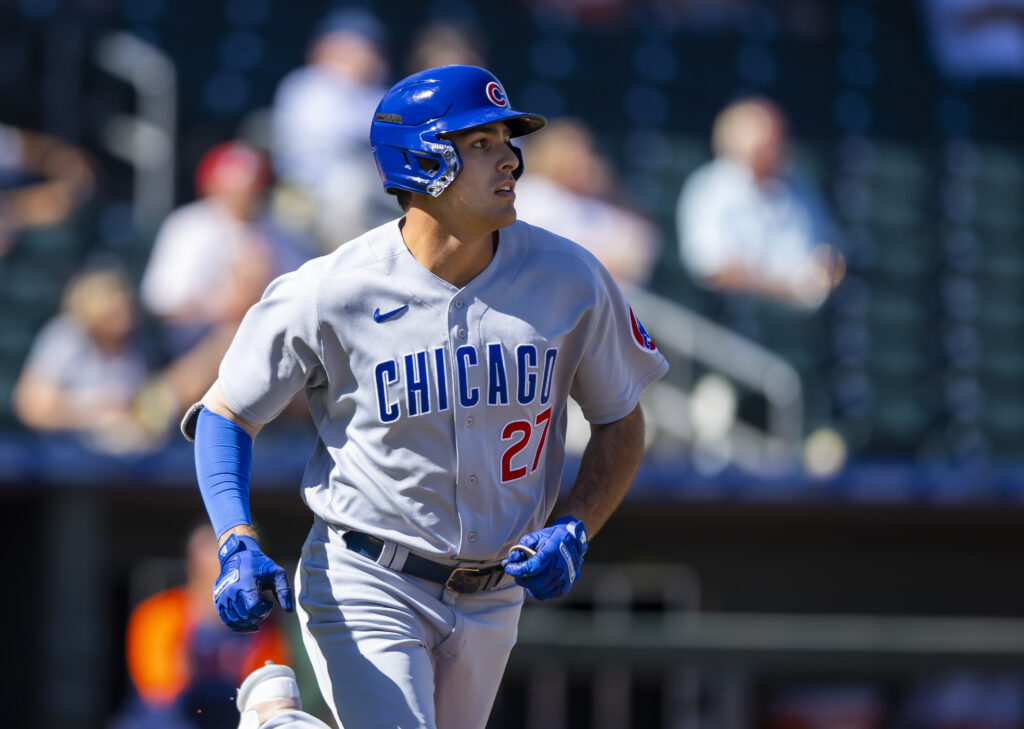
The average batting line for first basemen in 2022 was .246/.320/.410, wRC+ of 107. For the Cubs, they used various players at the cold corner for a combined slash line of .232/.304/.348, wRC+ of 86, that latter stat being 24th out of the 30 MLB teams. Given that disparity, the Cubs will undoubtedly be looking for better production in 2023. They might have an in-house solution in Matt Mervis, though they will also be looking for external upgrades this winter. “He’s very much in our plans,” Cubs president of baseball operations Jed Hoyer said about Mervis, per Sahadev Sharma and Patrick Mooney of The Athletic. “But I think we’re also going to be active in exploring alternatives.”
Mervis has really exploded onto the scene in 2022. As mentioned in the piece linked above, he didn’t get drafted in either 2019 or 2020, eventually signing with the Cubs as an undrafted free agent. He played 72 minor league games in 2021, hitting at a below-average level.
2022 has been a completely different story, however. He began the season in High-A and completely mashed, producing a batting line of .350/.389/.650, wRC+ of 189. He got bumped to Double-A and hit .300/.370/.596 for a wRC+ of 148. After moving to Triple-A, his line was .297/.383/.593, 152 wRC+. Incredibly, his walk rate improved from 4.6% to 8.7% to 10.4% as he moved up the ladder, while his strikeout rate fell from 24.1% to 20% to 14.6%. The Cubs decided to keep the good times rolling by sending him to the Arizona Fall League, where he hit .262/.324/.590 in 17 games.
It’s not just the bat that has the Cubs excited either. “He’s more athletic than people think,” Cubs vice president of player development Jared Banner said. “He knows his way around the bag at first base. He’s a nice, big target, and he actually grades out really well defensively. No concerns there.”
Despite that tremendous breakout season, it stands to reason that the Cubs don’t want to simply hand over the starting job to Mervis just based on that. “We’re thrilled with what he’s doing,” Hoyer said. “We know he’s a big part of where we’re going. But at the same time, we have to be cognizant of having real depth. Injuries and other things happen.”
With Mervis seemingly on the cusp of reaching the majors but not a guarantee to immediately succeed, it’s likely that the club will look for a short-term addition to first base. That way, should Mervis continue charging forward, he wouldn’t be blocked from securing the full-time job. The Cubs don’t really have a player locked into the designated hitter mix, so it’s possible that Mervis could co-exist on the roster with someone who will require a long-term deal like, say, Josh Bell. However, teams generally don’t like clogging up the DH spot and prefer to rotate players through there. That’s especially true of a team like the Cubs that’s still trying to give at-bats to young players and evaluate their capabilities against major league pitching. That being said, with no real lock for first or DH, the Cubs are one of the teams best suited to fit a bat-first player into their lineup.
MLBTR’s Top 50 had Josh Bell as the top available first baseman, predicted a contract of four years and $64MM, or $16MM per year. However, Jose Abreu was actually pegged for a higher contract in terms of average annual value: $40MM over two years. Abreu has a longer and more impressive track record but he’s more than five years older than Bell, hence the disparity. The White Sox seem set to let Abreu walk and replace him with Andrew Vaughn at first, and the Cubs have been reported to be interested in facilitating a crosstown move. Brandon Drury would be a sensible fit, if the Cubs are content with moving him to second or third base in the event Mervis takes over at first.
If the Cubs opt for a more short-term solution, players that can likely be had on one-year deals include Brandon Belt, Matt Carpenter, Trey Mancini, Yuli Gurriel or Wil Myers. There’s also the trade market, which could feature bats like Rowdy Tellez or Eric Hosmer. Tellez still has two seasons of arbitration control remaining and is projected for a $5.3MM salary this year by MLBTR contributor Matt Swartz. Hosmer still has three years left on his deal but the Padres agreed to pay down everything but the league minimum when trading him to the Red Sox.
There are many different options available to the club and how they proceed will depend on how much faith they have in Mervis and how much they want to spend. Last year, the Cubs gave out a whole bunch of one-year deals to veterans, with Seiya Suzuki’s five years and Marcus Stroman’s three years (with an opt-out after two) the only multi-year deals.
Credit : Source link






